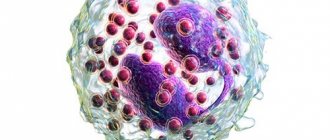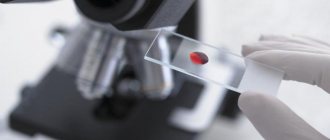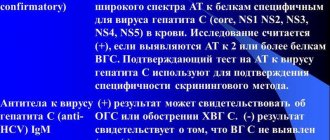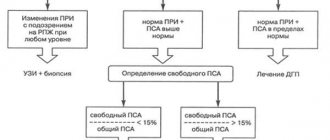In 2005, scientists Berry Marshall and Robin Warren were awarded the Nobel Prize in Medicine for their revolutionary discovery that sheds light on the causes of gastritis, duodenitis, duodenal ulcer and stomach cancer. They discovered the microbe Helicobacter pylori. Over the past few years, several methods have been developed for detecting this pathogen in the human body.
Many methods indicate that the “gold standard” in diagnostics has not yet been found. A blood test for Helicobacter pylori is one of the detection methods.
Why is it so important and so difficult to identify Helicobacter pylori?
What you need to know about Helicobacter pylori
The name means a spiral-shaped microbe that lives in the pyloric part of the stomach. For those who do not remember the anatomy, we remind you that this is the section of the stomach in the zone of transition to the duodenal bulb. The microbe actually has a spiral shape and flagella, and is an anaerobic, that is, it lives in the absence of air.
For a long time, the entire medical world was sure that there were no conditions for the life of microorganisms in the stomach because its internal environment was too aggressive. Gastric juice, necessary for digestion, contains hydrochloric acid produced by special cells in the inner wall of the stomach. The only one that has adapted to life in such an environment is Helicobacter.
He managed to develop 2 defense mechanisms:
- thanks to flagella, it burrows deep into the mucus that envelops the walls of the stomach;
- enhances the secretion of ammonia, which neutralizes hydrochloric acid.
Being under the mucus in close proximity to the cells of the inner layer of the stomach, Helicobacter “devours” them, releasing toxins. Gastric juice rushes into the defect area, irritating the mucous membrane and causing ulceration (the old theory about stress leading to ulcers has failed). In addition, Helicobacter pylori is recognized as a first-order carcinogen.
The importance of the examination is confirmed by the fact that carriage of the microbe is widespread; up to 60-80% of the world's population have this microbe in the stomach or duodenum. In Russia, in some regions the infection rate reaches 90%, in Moscow 60%. Not everyone gets sick. The disease is promoted by weakened immunity and neglect of personal hygiene rules, because the route of transmission is oral-oral.
You can become infected by kissing, sharing utensils, or licking nipples and spoons by your mother. Children are especially at risk of the disease. What matters is that this microbe is characterized by reinfection, that is, having not been treated enough, a person can again receive a new “portion” of the pathogen. This is realistic when using common dishes in the family.
The prevalence of gastrointestinal diseases is also high.
The following symptoms are familiar to many people:
- pain “in the pit of the stomach” before or after meals;
- frequent heartburn;
- feeling of heaviness after eating a small amount of food;
- nausea, vomiting, discomfort;
- appetite disorders;
- sometimes intolerance to meat foods;
- the appearance of mucus streaks in the stool.
The good news is that Helicobacter pylori responds well to treatment with antibiotics and acid-regulating medications.
Characteristics of the bacterium
More than half of the human population has Helicobacter pylori in the body, but not every person provokes the development of a pathological process.
It is a gram-negative bacterium that cannot survive in air. It is transmitted through saliva, mucus and food. The main route of transmission is household. It spreads especially quickly among members of the same family when people neglect simple hygiene rules, for example, mothers lick a pacifier and then give it to the baby. You can also become infected by kissing. After entering the body, Helicobacter pylori migrates to the stomach, where it can start a pathological process. But, not always penetrating inside, it causes disease. Whether pathology will develop largely depends on the patient’s general well-being and the state of his immune system.
Helicobacter is the only bacterium that is not destroyed by gastric juice, as it produces large amounts of ammonia that neutralizes hydrochloric acid. She has flagella that allow her to move quickly. It penetrates the mucous membrane of the digestive tract and destroys it, as a result, ulcers form in the gastrointestinal tract and inflammation begins.
Examination methods
Patients with established chronic gastrointestinal diseases and persons presenting the above-mentioned dyspeptic complaints, as well as patients who have completed a course of treatment (as a control over the effectiveness of treatment) are subject to examination for Helicobacter pylori. It should be borne in mind that asymptomatic carriage is possible. Weakened immunity, poor diet, alcohol and smoking, chronic stress, and psycho-emotional stress can lead to a transition from simple carriage to the development of the disease.
Examination methods are usually divided into those related to and unrelated to the need for fibrogastroduodenoscopy.
Invasive (associated with FGDS) techniques include:
- biopsy culture and bacteriological examination;
- biopsy histology;
- rapid urease test;
- polymerase chain reaction of biopsy specimen.
Non-invasive methods:
- serological or enzyme immunoassay of blood;
- urea breath test;
- Fecal polymerase chain reaction.
There is also a division of examination methods into direct (material taken from the subject is examined directly - biopsy, blood, feces) and indirect (urease tests, serological analysis).
Each of them has its own advantages and disadvantages; each, when decrypted, can give both false positive and false negative results. Therefore, a rule has been established according to which, in order to issue a conclusion about the presence or absence of Helicobacter pylori in a person being examined, he should conduct 2 or even 3 examinations using the methods of different groups.
The most accurate and fastest methods are recognized: PCR biopsy and urease breath test.
Today we will talk about an enzyme immunoassay blood test for Helicobacter pylori.
PCR analysis
This blood test is considered the most reliable, as it allows you to detect whether Helicobacter pylori DNA is currently in the body or not.
A positive result indicates that the pathogen is present in the body, a negative result indicates that it is not.
However, based on this study, it cannot be concluded that Helicobacter pylori has begun its negative impact on the body. You can donate blood for PCR if the patient has not undergone antibiotic therapy.
Although, having the test results and normal values in hand, you can try to decipher them yourself, it is still better to entrust this to a doctor, since only a doctor can do it correctly.
Enzyme immunoassay blood test for Helicobacter
This analysis is a non-invasive direct method for detecting helicobacteriosis.
An enzyme-linked immunosorbent test does not determine the pathogen itself, but the presence of specific proteins in the serum - antibodies produced in response to the introduction of the pathogen (antigen) into the human body. These antibodies are glycoproteins and are produced by plasma cells formed from B lymphocytes (the cellular component of immunity) in response to antigen. Antibodies are located on the surface of B-lymphocytes in the form of membrane-binding receptors and in the blood serum (humoral immunity).
Antibodies are specific, that is, their own antibodies are produced for each antigen.
They are otherwise called immunoglobulins. In humans and mammals, there are 5 types of immunoglobulins, of which Ig A, M, G are the most important. The first 2 indicate the early stage of the disease, when no more than 1-2 weeks have passed since the microbe entered the body. They are called acute phase proteins. IgG increases from 3-4 weeks and lasts for one and a half years after treatment in half of the patients.
The technique exists in 2 types:
- qualitative determination of the presence of antibodies;
- quantitative determination of concentration (titer).
The first allows you to determine the presence or absence of antibodies, and therefore Helicobacter, the second makes it possible to monitor the progress of treatment and the degree of removal of the microbe from the body.
ELISA for bacteria
This test is prescribed to determine the concentration of antibodies in the blood relative to the bacterium. It is easy to carry out, the main thing is that the laboratory assistant has a lot of experience and is able to carry out the research properly. During the study, the amount of antibodies to Helicobacter is determined through various chemical reactions.
It is generally accepted that antibodies never appear just like that. And if they are present in the blood, as, for example, in the case of Helicobacter, it means that it is definitely in the body, and it is trying to fight it. True, we must remember that in order for antibodies to appear, that is, to be developed, the immune system must respond to the “stranger.” And for this to happen, it should take approximately one to two weeks.
False-negative results of blood tests are only possible when the bacterium is present in the body, but the person’s immune system has not yet had time to respond to it due to certain circumstances.
As for false positive results, they can be obtained only in two cases. In the first, if it was a mistake of the person who conducted the research (mixed up the material, wrote the conclusion incorrectly, etc.), in the second, if the person was cured of the bacteria, but antibodies are still present in the blood. They usually persist for several days after complete recovery.
More information about the bacterium Helicobacter pylori can be found in the video.
Having received the ELISA results, we can only guess whether Helicobacter is present in humans or not. If the result is positive, then it is necessary to conduct a more complete examination, as well as take an extended blood test, which can provide more information about the condition of the body.
Pros and cons of ELISA
An undoubted advantage is that the method does not require fibrogastroduodenoscopy, which is especially important for children.
The enzyme immunoassay for Helicobacter pylori is highly effective, its effectiveness reaches 92%, and for IgG 100%. It not only makes it possible to detect the disease in the early stages, but also allows one to judge the effectiveness of the treatment based on titer deviations. The method is available to most patients both in price and location.
The disadvantage of this method is that it produces false positive and false negative results.
A false positive result is observed in persons treated the day before with antibiotics for any other reason. In those treated for Helicobacter, the titer persists for up to one and a half years.
A false negative test may occur at a very early stage, when the microbe has entered the body, but the immune system response is delayed. Low titers are observed when taking some cytostatics. A complete enzyme immunoassay for immunoglobulins A, M, G helps differentiate the situation.
Do not forget about the need to supplement the examination with 1-2 more methods.
Decoding cytology
Cytology is the examination of material under a microscope. Biomaterial is taken from smears of stomach mucus. For the purpose of visual detection, they are painted with a unique dye, enlarged and studied. If the entire mycobacterium is found in the smears, this means that the person is infected. When Helicobacter pylori is positive, the specialist assesses the degree of infection:
- “+” – up to 20 bacteria in the field of view.
- “++” – up to 50 mycobacteria.
- “+++” – more than 50 mycobacteria.
The “+” value means weakly positive helicobacteriosis, that is, the mycobacterium is present, but insemination is insignificant. “+++” says that mycobacteria are active, there are many of them, and the inflammatory process requires healing.
Indications and contraindications
The range of people subject to examination using the ELISA method is quite wide:
- stomach and duodenal ulcers;
- dyspepsia;
- inflammation of the esophagus;
- atrophic gastritis;
- gastrointestinal oncology in loved ones;
- Helicobacter pylori in the family;
- assessment of treatment effectiveness;
- intolerance to meat and fish;
- feeling of heaviness in the stomach after eating;
- belching sour, heartburn;
- “hungry” pains, “sucks in the pit of the stomach”;
- bloating;
- weight loss for no apparent reason;
- nausea and vomiting;
- blood in stool or vomiting.
If the patient is agitated and there are seizures, the analysis is not performed. When performing venipuncture, you need to pay attention to the absence of signs of inflammation of the skin and the area of the vein in the area of the intended sampling.
Preparing for the test
Preparation for taking an ELISA test for Helicobacter pylori involves prohibiting the consumption of fatty foods and alcoholic beverages on the eve of the test. The gap between the last meal and the analysis should be at least 8–10 hours.
Physical activity should be stopped the day before the examination.
The test is taken in the morning, before breakfast, and you are allowed to drink water before the test.
You should not smoke 30 minutes before donating blood.
It is advisable to undergo examination before starting antibiotic therapy.
Monitoring of the effectiveness of treatment is carried out 2 weeks after the end of taking antibiotics.
Blood is collected by venipuncture of the cubital vein; the material is placed in a sterile tube with a coagulant gel to separate the serum. The test tube can be stored at a temperature of +20.
The test result for IgG is ready in a day, for all immunoglobulins in 8 days.
How to decipher urease testing
The blood test for Helicobacter pylori is interpreted by a doctor. The express test for mycobacterial urease fermentation is based on the number of microbes. The doctor gives a positive assessment if the color of the indicator changes, and the speed and severity are described not in numbers, but in the same pluses.
If there is no staining or appears after 24 hours, this means that the patient does not have Helicobacter. The more positives, the more serious the level of infection. So, if staining occurred within 5 minutes, a mark “+++” is made, this means significant infection. If the color appears within a couple of hours, the infection is moderate and is marked “++”. A change in the indicator over 24 hours is assessed as a minor infection.
Decoding the analysis results
If the test was carried out in a qualitative version, that is, without determining the quantitative values of immunoglobulin titers, then the norm is the absence of antibodies to Helicobacter pylori, which will be reflected in the study form. It should be borne in mind that if there is one or more of the complaints listed above, a negative result does not provide grounds to assert that this patient does not have helicobacteriosis. It is recommended to repeat the analysis after 2 weeks and, in addition, conduct a urease breath test or any other one suggested.
Interpretation of quantitative analysis is based on comparison of the obtained titres with reference values. Each laboratory has its own sets of reagents, so the norm both in digital terms and in units of measurement differs from others. The form must indicate the norms and units accepted in this laboratory. The titer values obtained during patient examination are compared with standard ones. Indicators below the reference ones indicate a negative result, that is, that no antibodies to Helicobacter were found. Indicators above the reference ones indicate a positive result.
If the laboratory gives a “doubtful” result, the examination should be repeated after 2-3 weeks.
TABLE OF ASSESSMENT OF THE TEST FOR IMMUNOGLOBULIN IgG TITERS TO HELICOBACTER PYLORI. NORM AND DEVIATIONS
RESULT
S\CO INDICATORS UNITS\ML INDICATORS
Negative less than 0.9 less than 12.5
Doubtful 0.9 – 1.1 12.5 – 20.0
Positive more than 1.1 more than 20.0
In IFE units, the norm for immunoglobulin A and G is 30 IFE.
Positive values of immunoglobulin A over 30 IFE indicate:
- early period of infection, latent active process;
- chronic form of the disease.
- For immunoglobulin G, positive values over 30 IU mean:
- residual antibodies after treatment;
- phase of active inflammation, risk of developing gastritis, peptic ulcer, oncology;
- simple carriage of the bacterium in the absence of symptoms;
- indicates a fresh infection, about a week old.
Negative values of less than 30 IFU for immunoglobulin A indicate:
- recent infection;
- stage of convalescence or continuation of antibiotic therapy;
- negative Helicobacter when combined with a similar response for immunoglobulin G.
A negative value of less than 30 IU immunoglobulin G suggests:
- absence of infection, but with a small risk of development;
- early infection within 28 days.
- A negative immunoglobulin M titer means:
- early infection (first decade);
- adequate antibiotic therapy;
- convalescence stage;
- negative results similar to those for other antibodies.
An increase in all titers for all antibodies indicates an aggressive inflammatory process. ELISA can be positive in healthy people who are simply carriers of Helicobacter pylori. This conclusion can be made after a thorough laboratory and clinical examination of the patient.
Fast laboratory diagnostics allows you to immediately begin treatment and select effective treatment regimens for bacteria in order to eradicate them as quickly as possible.
During treatment monitoring, an indicator of effectiveness is a decrease in antibody titre by 20-25% within six months.
General information about mycobacteria
Helicobacter pylori (Helicobacter pylori) is an opportunistic mycobacterium of a spiral shape, with a Gram-red tint (gram negative). Mainly lives in the body in the gastric chamber and duodenum. The fact that pylori is responsible for the formation of stomach and intestinal diseases was denied for many years. Only in 2005, doctors from Australia managed to prove the therapeutic value of mycobacteria, for which they received a Nobel Prize.
On a note! In 90% of people, this bacterium is part of the normal microflora and does not cause infection. But there is an opinion that it is precisely this that is the cause of gastrointestinal pathologies.
Helicobacter Pylori IGG is a microbe that can provoke infection in the presence of factors positive for the bacterium. For example:
- prolonged use of antibacterial drugs with further dysbacteriosis;
- decreased immune system;
- presence of concomitant diseases.
But when infected with strains with pronounced pathogenic properties, the presence of these factors is not necessary.
Where can you get a blood test for Helicobacter?
There are 2 options to get tested. The first option is to make an appointment with a general practitioner or gastroenterologist. If he deems it necessary, he will give a referral for examination at the district clinic. You should be prepared to wait a while until your turn for a free examination comes.
According to the second option, you can sign up for an examination in a private clinic yourself via the Internet. You choose the time convenient for you. The cost of analysis varies among different clinics. On average, determining the titer of immunoglobulin A and M will cost approximately 850 rubles each, and immunoglobulin G 450 rubles. A comprehensive examination for 3 types of antibodies will cost a little more than 2,000 rubles. There are more than 100 addresses of private clinics in Moscow where you can undergo examination.
It is advisable to visit the doctor once every 6 months so as not to miss the onset of the pathological process.
As an example, we can recommend the Invitro laboratory network. It has existed for more than 20 years and has 9 modern laboratory centers with a network of about a thousand offices in Russia, Eastern Europe and neighboring countries. Invitro provides more than 1,700 state-of-the-art tests and medical services.
The company has twice won the “Brand No. 1 in Russia” award – a symbol of people’s trust.
The system for assessing the quality of laboratory research is standardized according to international standards. Certificates, licenses for the right to conduct laboratory research, and modern equipment have gained confidence in the analyzes performed by many medical institutions in Russia and beyond.
A discount program and discount system are provided for patients. There is also a service for interpreting the results of the analysis by a doctor-consultant free of charge online in the Internet club or by telephone, which does not exclude a face-to-face consultation to prescribe appropriate treatment.
The cost of testing for antibodies to Helicobacter pylori corresponds to the Moscow average - 590 and 825 rubles.
Immunoglobulins in the blood
When any microorganism enters the body, blood cells immediately begin to produce special proteins called immunoglobulins, the main task of which is to suppress the growth and reproduction of the pathogen. Likewise, when Helicobacter pylori enters the body, immunoglobulins LgG, LgM, LgA begin to be released. But they also do not begin to be produced immediately, but only when negative consequences of infection are observed. Depending on the amount of immunoglobulins, further treatment tactics will be prescribed.
Interpretation of test results
The results of the Helicobacter norm in different laboratories may differ. When you receive the test form, it will indicate normal values, and when the numbers obtained are below these values, the result is negative, i.e. the pathogen is absent in the body, if the above is positive (microorganisms multiply and the pathological process has begun).
If found in blood:
- immunoglobulins LgG, which means Helicobacter pylori is present in the body, as a rule, it is detected in the blood 3-4 weeks after infection, persists throughout the illness and for some time after recovery;
- immunoglobulins LgM, therefore the patient’s pathology began recently, but, as a rule, they are rarely detected, since most people go to the hospital when the disease is already advanced;
- LgA immunoglobulins may also indicate that the disease has recently begun or that the gastric mucosa is very inflamed; this type of immunoglobulin is also detected very rarely, since many people take tests when the pathological process has already started.
Important! If the patient has nothing to do with medicine, then he will not be able to correctly decipher the test results obtained, even if he knows what each immunoglobulin is responsible for. And besides, by how much the obtained numbers differ from the norm, the doctor will be able to assess the severity of the pathological process.
To treat or not to treat?
Today, the issue of treating patients with positive test results in the absence of complaints and in the absence of inflammatory and ulcerative changes in the gastrointestinal tract remains controversial. Most are inclined to refuse treatment.
In the presence of an ulcer or gastritis, the need for Helicobacter eradication is beyond doubt due to the tendency of such a process to become malignant. In each specific case, the decision to prescribe individual therapy is made by a gastroenterologist based on the patient’s complaints, results of laboratory tests and instrumental studies.
The problem of treatment is so important that once every 5-6 years, scientists from all over the world gather under the auspices of the World Health Organization for an international congress, where they discuss treatment tactics, classes of antibiotics for eradication of the pathogen, diagnostic methods and preventive measures. Accepted agreements become a guide to action.
According to reviews from patients with complaints of digestive problems, treatment with two antibiotics in combination with metronidazole and antacids caused significant improvement or even recovery.
In terms of prevention, you should pay attention to observing the rules of personal hygiene, washing dishes thoroughly, not giving or taking bitten fruits and sweets from others, not kissing people you don’t know, not smoking one cigarette, not using someone else’s lipstick, having your own toothbrush and toothpaste. . These simple methods can prevent infection and avoid many unpleasant moments.
If you have the slightest complaint, do not blame everything on errors in nutrition, consult a doctor, get tested for Helicobacter pylori and follow your doctor’s recommendations.
Good results in your examination.
Blood composition
Antibodies to Helicobacter pylori quickly form in the serum. The picture is characterized by a quantitative change in intelekins:
- Increase in the number of IL-6, 8 and 10.
- Reduced IL-2 levels.
However, studies conducted on adolescents have found discrepant patterns between children and adults. From 14 to 17 years of age, no quantitative changes in cytokines were recorded in people. The teenagers donated blood for Helicobacter, and no differences were found in the content of interleukins, necrosis factors and interferons.
Blood components
What are cytokines
Cytokines have not yet been sufficiently studied, so diagnosis in this regard is rather speculative. What was said above. Doctors are still figuring out the relationship between the concepts of Helicobacter pylori, blood test, normal and cytokines.
The structures described are protein complexes formed as a response of the immune system. Cytokines are similar in configuration to hormones, but their functions have not yet been studied. Here are some assumptions about this:
- Control of blood cell production and differentiation.
- Balancing the immune system.
- Regulation of inflammation processes.
- Maintaining normal blood pressure and coagulation.
Cytokines today are constantly replenished with new representatives of the class. Doctors divide them into classes as follows:
- Interleukins.
- Interferons.
- Chemokines.
- Monokines.
- Lymphokines.
- Colony-stimulating factors.
Cytokine molecules
When a study was conducted on the then new infection Helicobacter pylori, doctors found an increased background of IL-1 beta and IL-6 (on the mucous membrane, not in the blood). Over time, it became clear that the inadequate reactions of the immune system, which refuses to fight the infection and gradually switches to autoimmune reactions, are caused by the cytokines that are formed. These substances penetrated into the cytoplasm of cells and the intercellular substance.
That is why today a positive blood test is interpreted as a source of problems in the cardiovascular system, skin diseases, anemia and others. When helicobacter pylori is eradicated, a decrease in the level of tumor necrosis factors alpha, IL-8 and IL-1 beta is primarily recorded.
Not all strains provoke such changes, but those that contain the CagA antigen do. IL-8 is a provocateur of inflammation in the body.
Antibodies
When doctors were faced with the problem of replacing a biopsy due to the complexity of the procedure, they came up with a host of other methods. Tests for antibodies in the blood fall into this category. The test is considered non-invasive, although it is performed using a syringe. Initially, the antibody test resembled that done for Campylobacter. Through the cross-reaction of antigens, doctors resolved the issue of their presence in the blood serum.
As for studies on specific factors, for example, CagA, it was decided that this approach was inappropriate due to poor sensitivity.
The presence of IgG does not indicate the presence of infection. It is possible to detect this fragment during analysis over a long period of time. Due to the sharp decline in carriers of the infection in developed countries, it is possible to determine the presence of IgG in those who have long received a negative status for the presence of the microbe.
Gradually, antibody titers fall. A paired analysis (before and after treatment) is required to understand what the diagnosis is. Therefore, it is not possible to identify single figures for an individual patient. The decline in titers lasts for decades. Today, doctors suggest assessing the success of treatment by a 50% reduction in 6 months. This sign is characterized by increased sensitivity (97%) and specificity (95%).
Today, IgA and IgM immunoglobulin tests are not approved in developed countries. Because the reliability indicators leave much to be desired.
Other markers of the presence of infection
In addition to the morphological signs recorded by instrumental methods (gastritis, ulcers, etc.), clinical signs are distinguished, such as severe hunger. This is due to the biochemical composition of the blood - increased levels of gastrin. A weakly positive increase in pepsinogen levels is considered a risk factor for the development of ulcers. However, this factor does not indicate the formation of the disease, but reveals a marker for the presence of Helicobacter in the blood.
At first, this trait was attributed to genetically inherent in the human body. Since the same is typical for autoimmune gastritis. However, re-analysis of the situation showed that bacteria was the cause. So doctors consider the level of pepsinogen and gastrin in the blood to be a significant argument in favor of the diagnosis. So, with an increase in the ratio of pepsinogens I and II by 25%, it’s time to take a closer look. Furuta reports a specificity of this technique of 90% of cases and a sensitivity of 95%.
The hypothesis was tested by assessing IgG titers after treatment of infection. 2 weeks after treatment, doctors recorded a decrease in gastrin. However, to take a blood test using this method, you will have to do it twice with an interval of 6-12 months.
Analysis of the result
The result is assessed, for example, by the amount given by antibodies to Helicobacter (immunoglobulins A, M and G):
- 0.8 – total indicators indicate a negative answer about the presence of a diagnosis.
- 0.8 – 1.1 – additional research is required.
- More than 1.1 means that an infection is localized in the stomach.











